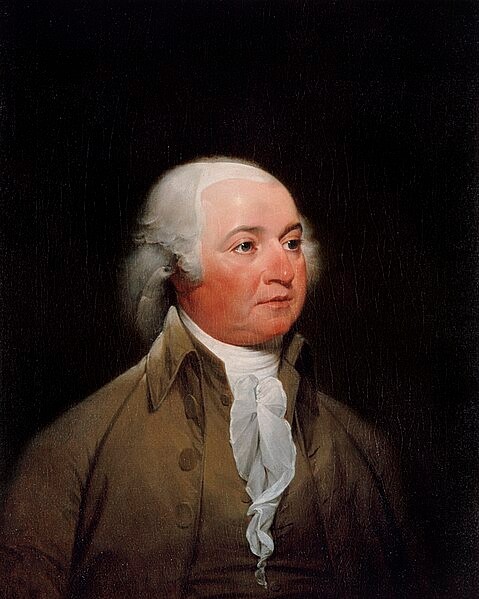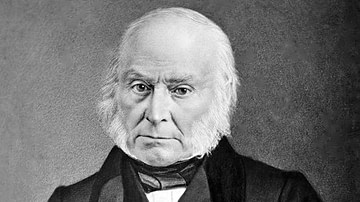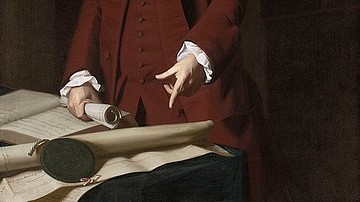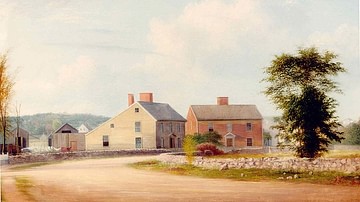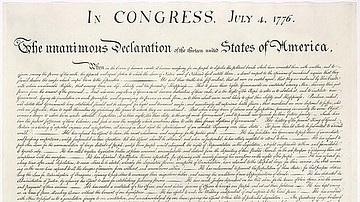
John Adams (1735-1826) was an American lawyer, statesman, and diplomat who was a prominent leader of the American Revolution (1765-1789) before going on to serve as the first vice president (1789-1797) and second president of the United States (1797-1801). He is considered a Founding Father of the United States, having helped lead the push for independence.
Early Life
John Adams was born on 30 October 1735 in Braintree, Massachusetts. His father, John Adams Sr., was a farmer, shoemaker, church deacon, and selectman for the town of Braintree, who was well-liked in his 2,000-person community. The younger John greatly admired his father, later writing of him that "in wisdom, piety, benevolence, and charity…I have never known his superior" (McCullough, 33). John's mother, Susanna Boylston Adams, came from one of the most prominent medical families in New England; her uncle Zabdiel Boylston was the first American physician to perform smallpox inoculations. John had two younger brothers, Peter and Elihu, and spent his childhood "making and sailing boats…swimming, skating, flying kites and shooting marbles…running about to quiltings and frolics and dances among boys and girls". As Adams would later recall, his childhood "went off like a fairytale" (McCullough, 31).
In 1751, at the age of 16, John Adams enrolled in Harvard College with the encouragement of his father, who had hoped that his son would become a minister. Yet, Adams realized he was better suited for a career in law. After graduating from Harvard in 1755, he took a job as a schoolteacher in Worcester, Massachusetts, to sustain himself while he studied law under James Putnam, one of the most prominent lawyers in Worcester. He was admitted to the bar on 6 November 1759 and began practicing law in Braintree and Boston. He lost his first case on a technicality, which temporarily shook his self-confidence, but he continued to dedicate himself to the study of law. By 1762, his practice had taken off, and he was soon riding the circuit of Massachusetts courts with the royal judges.
In 1759, Adams was introduced to 15-year-old Abigail Smith, a shy, delicate-looking girl who had been frequently ill in her childhood. At first, Adams took little interest in Abigail, writing that she and her sisters were neither "fond, nor frank, nor candid" (McCullough, 52). But the pair became closer in the following years, bonding over their shared love of books. In 1761, upon the death of his father, Adams inherited nine acres of land and a farmhouse in Braintree; he and Abigail lived there after their marriage on 25 October 1764. The couple would ultimately have four children who survived childhood: Abigail ‘Nabby' Adams (1765-1813), John Quincy Adams (1767-1848), Charles Adams (1770-1800), and Thomas Boylston Adams (1772-1832). Another daughter, Susanna (b. 1768) died before her second birthday while the couple's final child, Elizabeth, was stillborn in 1777.
Revolutionary Lawyer
In 1765, word reached Boston that Parliament planned to impose the Stamp Act on the Thirteen Colonies, which would place a tax on all paper documents. Adams' second cousin, Samuel Adams, became an outspoken critic of the policy, arguing that Parliament's attempts to directly tax the Americans without their consent were tantamount to tributary slavery; the phrase ‘no taxation without representation' became a rallying cry for the Whig, or Patriot, movement, which opposed the tax. John Adams, too, publicly opposed the Stamp Act; though he was initially less famous than his outspoken cousin, he penned several essays for the Boston Gazette in which he argued that the rights and liberties of Americans were firmly entrenched in British constitutional law and could not be disregarded. Around the same time, he authored the Braintree Instructions, a letter sent to the Massachusetts General Court on behalf of the residents of Braintree, in which Adams proclaimed that "no freeman should be the subject to any tax to which he has not given his own consent" (McCullough, 61). Parliament repealed the Stamp Act in 1766, and tensions subsided in Boston – until the following year when Parliament imposed another series of direct taxes in the Townshend Acts.
In 1768, the Liberty, a sloop owned by wealthy Boston merchant John Hancock, was seized by British customs officials, on the pretext that it carried smuggled goods. Adams, who had risen to become one of Boston's most prominent lawyers, successfully defended Hancock in court, though he disapproved of the anti-British riots triggered by the Liberty Affair. These riots prompted Parliament to send soldiers to Boston to restore order, a move that only increased tensions in the city. On 5 March 1770, nine British soldiers fired into a mob of colonists, killing five. The soldiers, under the command of Captain Thomas Preston, were swiftly arrested. While the Boston Massacre was met with furious outrage throughout the colonies, Adams agreed to defend the soldiers at trial; although he was an opponent of Parliament's policies, he believed that everyone was entitled to a fair trial.

He first defended Captain Preston in a week-long trial that began on 24 October 1770. Preston was acquitted after Adams convinced the jury that there was insufficient evidence that he had commanded the men to fire. In December, Adams defended the other eight soldiers, claiming that they had come under attack by the mob, which had begun pelting them with snowballs and chunks of ice and had been calling for their deaths. To remove the blame from his fellow Bostonians, Adams argued that the mob had been made up of "molattoes, Irish Teagues, and Jack Tars (i.e. sailors)", all of which were considered outsiders (Zabin, 216). "Facts are stubborn things," Adams concluded, "and whatever may be our wishes, our inclinations, or the dictums of our passions, they cannot alter the state of facts and evidence" (McCullough, 68). After a two-hour deliberation, six soldiers were acquitted, while two were found guilty of manslaughter, given the relatively light sentence of having their thumbs branded. It was Adams' greatest success as a lawyer.
Continental Congress
After the Boston Massacre, relations between Great Britain and the colonies continued to deteriorate. In response to the Boston Tea Party (16 December 1773), Parliament passed the so-called Intolerable Acts, closing the port of Boston to commerce and suspending representative government in Massachusetts. In September 1774, Adams attended the First Continental Congress in Philadelphia, which condemned the Intolerable Acts and petitioned the king for their repeal. After the first shots of the American Revolutionary War were fired at the Battles of Lexington and Concord (19 April 1775), Adams once again went to Philadelphia, this time as a delegate to the Second Continental Congress, the wartime government of the rebelling colonies.
Adams quickly stood out as a leader in the Continental Congress. It was he who nominated George Washington to command the newly formed Continental Army on 14 June 1775 – much to the chagrin of Hancock, who had wanted the job for himself. By early 1776, as the war continued to escalate, Adams realized that reconciliation with Great Britain was no longer possible and became a leading advocate for independence. Together with his cousin Samuel and ally Richard Henry Lee of Virginia, he spearheaded the push for independence within Congress and drafted the preamble to the Lee Resolution, which proposed a formal separation between the colonies and Britain. As the congressional delegates prepared to vote on the resolution, Adams put together a Committee of Five – himself, Benjamin Franklin, Thomas Jefferson, Roger Sherman, and Robert R. Livingston – to draft a Declaration of Independence in case the vote carried. On 2 July 1776, Congress voted in favor of independence, and the Declaration was adopted two days later.
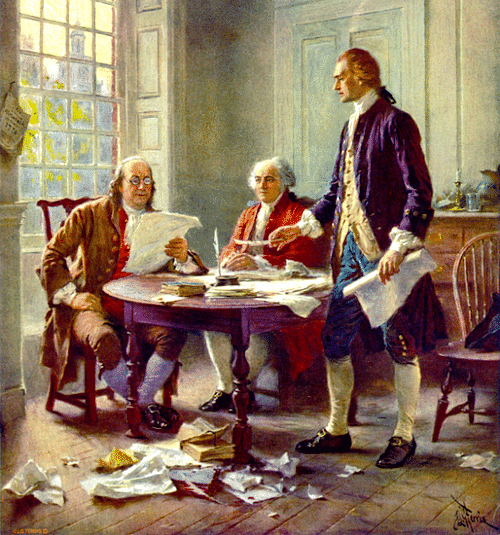
During his two years in Congress, Adams sat on 90 committees and chaired 25 of them. As the head of the Board of War, he closely worked with officers of the Continental Army and oversaw the creation of the Continental Navy; often working 18-hour days, he was referred to as a one-man war department. He drafted the Plan of Treaties in July 1776, which laid the groundwork for a treaty of alliance with France and, following Washington's defeat at the Battle of Long Island (27 August 1776), was selected as one of the three commissioners to discuss peace with British Admiral Lord Richard Howe. The resultant Staten Island Peace Conference quickly broke down as the Americans would not retract independence. On 27 November 1777, Adams agreed to serve as a commissioner to France and was sent to Paris to aid Benjamin Franklin and Arthur Lee in negotiating an alliance.
Diplomat
On 12 February 1778, Adams sailed for Paris aboard the frigate Boston, accompanied by his ten-year-old son John Quincy. He arrived in Paris in April, only to learn that a Treaty of Alliance had already been concluded. Adams was not impressed with his fellow commissioners – he viewed Arthur Lee as a paranoid cynic who saw spies everywhere, while Franklin was a tired old man much too eager to please the French. He continued to serve in France until September 1778, when Congress appointed Franklin as the sole plenipotentiary to the Court of Versailles. Congress' instructions neglected to mention Adams, leaving him feeling frustrated and underappreciated. He decided to return to Braintree, arriving on 2 August 1779.
Adams remained in Massachusetts long enough to help draft the state's constitution, which soon became the model for other states. In November 1779, he was sent back to Europe, charged with negotiating peace and a treaty of commerce with Britain. During the voyage, his ship sprung a leak and had to make port in Ferrol, Spain; rather than wait for the ship to be repaired, Adams travelled overland by mule, crossing the Pyrenees and arriving in Paris in January 1780. He spent the next six months at the French court, gradually realizing that France was losing faith in the American alliance and may be less forthcoming with future aid. To reduce the United States' reliance on French aid, Adams took it upon himself to travel to Amsterdam, to try and drum up support from the Dutch Republic.
Such was not to be an easy task – the Dutch were fearful of provoking British wrath by recognizing the United States. Adams spent the next year lobbying for support, publishing a 16-page memorial in April 1781 in which he made an impassioned plea for a Dutch alliance. He fell dangerously ill with a disease that may have been malaria or typhus, but he soon recovered. In November 1781, word reached Amsterdam of Washington's victory at the Siege of Yorktown (28 September to 19 October 1781); Adams capitalized on the momentum to demand the Dutch answer his memorial. The Hague recognized the independence of the United States in April 1782, allowing Adam to secure a loan of 5 million guilders from Dutch bankers. "If this had been the only action of my life," he wrote to Abigail, "it would have been well spent" (McCullough, 272). But he was not yet finished. In October 1782, he returned to Paris to join Franklin, John Jay, and Henry Laurens in negotiating peace with Britain. The resultant Treaty of Paris of 1783 was quite favorable to the United States and ended the war after eight years of fighting.
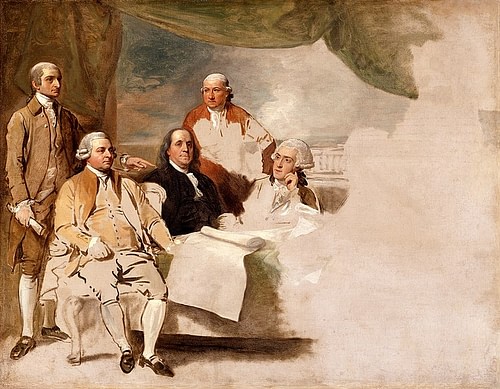
In 1785, Adams was sent to London as the first American ambassador to Great Britain. On 1 June, he had his first audience with King George III of Great Britain (r. 1760-1820), during which he expressed his hope to restore goodwill between people who, "though separated by an ocean and under different governments, have the same language, a similar religion, and kindred blood" (McCullough, 336). The king, for his part, answered that despite being the last to consent to separation, he would now be "the first to meet the friendship of the United States" (ibid). Adams remained in London for the next three years. He was joined by Abigail and was often visited by Thomas Jefferson, serving as ambassador to France. During this period, Adams and Jefferson formed a close friendship. By the late 1780s, Adams had become disturbed by troubling news from home – Shays' Rebellion (1786-87) had erupted in Massachusetts, while the nation was experiencing a crisis over the weak Articles of Confederation. In 1788, he resigned his ambassadorship and set sail for home.
Vice Presidency
Adams returned to Massachusetts in June 1788, around the time that the new United States Constitution had been ratified by the necessary nine states. Shortly thereafter, George Washington was unanimously elected the first president of the United States; since Washington was from Virginia, it was deemed appropriate that a Northerner serve as his vice president, leading to Adams' election. He arrived in New York City on 21 April 1789, little knowing what his new duties would entail; indeed, the only role of the vice president explicitly stated in the Constitution was to preside over the Senate and cast a tie-breaking vote there, if necessary.
Adams found himself supporting most of the official policies of the Washington Administration, although he rarely attended cabinet meetings and was not often consulted for advice; Adams himself would later refer to the vice presidency as "the most insignificant office that ever the invention of man contrived" (Britannica). He was, however, a strong supporter of the burgeoning Federalist Party, centered around the leadership of Alexander Hamilton; the Federalists believed in a strong central government. When Washington declined to stand for a third term in 1796, Adams stood for office as a Federalist. He won the presidency by a margin of 71-68 electoral votes; according to the protocol of the day, the runner-up, Jefferson, became vice president.
Presidency
Adams was sworn into office on 4 March 1797. To ensure a smooth transition, Adams decided to retain most of Washington's cabinet; many scholars consider this a mistake, as the cabinet was more loyal to Hamilton than to Adams. Much of his presidency was influenced by the ongoing French Revolutionary Wars. Adams and the Federalists hoped to continue the Washington Administration's policy of neutrality, while the rival Democratic-Republican Party (headed by Vice President Jefferson) wanted to support Revolutionary France against Britain. With Franco-American relations rapidly deteriorating, Adams sent a commission to Paris in July 1797 only to find that the French were demanding bribes as a prerequisite to negotiations (the XYZ Affair). Insulted, Adams recalled the commission and began a naval program.
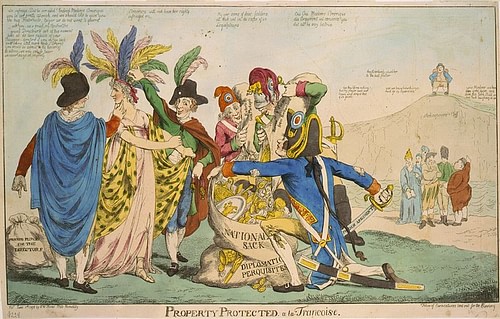
Rising tensions with France led Adams to pass the Alien and Sedition Acts in 1798, widely considered one of the low points of his career. The acts allowed the president to arrest or deport non-citizens residing in the US, as well as indict newspaper editors who published material considered to be "false, scandalous, and malicious" about the federal government. This outraged and disgusted the Democratic-Republicans, with Jefferson condemning the acts as unconstitutional. In May 1798, a French privateer seized an American merchant ship, sparking an undeclared naval conflict called the Quasi-War (1798-1800). The conflict, which ended shortly after Napoleon's rise to power, negated the 1778 Treaty of Alliance between the two nations. The peace agreement, made in 1800, caused a rift among the Federalists, as the Hamiltonian wing of the party still viewed Revolutionary France as a threat.
In June 1800, Adams moved the seat of government to Washington, D.C., the new federal city built on the Potomac River. By this point, Adams was running for re-election, once again pitted against Jefferson. Tensions were running high between the political parties, and the candidates were reduced to lobbing personal insults at one another; the once close friendship between Adams and Jefferson was destroyed, not to be mended for over a decade. But the rift within the Federalist Party, and the political maneuvering of Aaron Burr, cost Adams the victory. In his final weeks before leaving office, Adams made several appointments to the judiciary, including naming John Marshall as Chief Justice of the United States. These so-called ‘midnight judges', mostly Federalists, assured that the Democratic-Republicans would not have total control over the federal government. Adams left office on 4 March 1801 after a single term and retired to his farm in Quincy, Massachusetts (Braintree had become a municipality of Quincy in 1792).
Later Years
After leaving Washington, D.C., Adams largely refrained from commenting on public affairs, believing it was not his place to criticize the sitting administration. He celebrated when John Quincy was elected to the Senate in 1803 and supported his son when he broke with the Federalist Party in 1808. Adams became more vocal after Jefferson left the presidency, voicing his support for the War of 1812 against Britain. In 1812, Adams reconciled with Jefferson, and the pair took up a spirited correspondence, sending 158 letters over the next decade. In August 1813, tragedy struck when Adams' oldest daughter, Nabby, died after a three-year battle with breast cancer. Five years later, Abigail Adams died of typhoid fever.
Adams lived long enough to see John Quincy elected to the presidency after the exciting, four-way presidential election of 1824. Although Adams celebrated his son's victory, he told those who came to wish congratulations that, "no man who ever held the office of president would congratulate a friend on obtaining it" (McCullough, 639). On 4 July 1826, the 50th anniversary of independence, John Adams died in his home in Quincy as a thunderstorm raged outside. He was 90 years old. Jefferson had died the same day, only hours before, and both their deaths were mourned by the nation they had helped forge.


